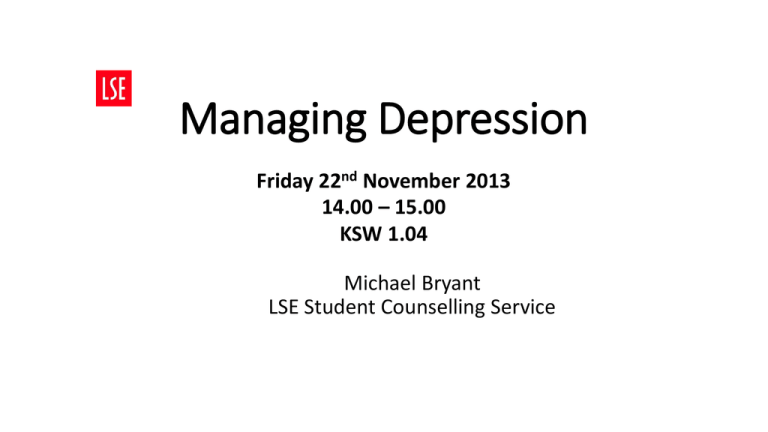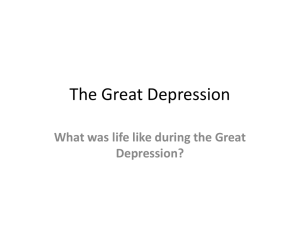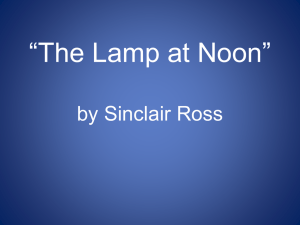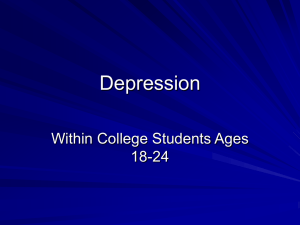
Managing Depression
Friday 22nd November 2013
14.00 – 15.00
KSW 1.04
Michael Bryant
LSE Student Counselling Service
Depression:
Living with the Black Dog
What is depression?
Depression is common. Symptoms can affect day-to-day life and can
become very distressing.
Treatments include psychological (talking) treatments and
antidepressant medicines.
Treatment takes time to work but has a good chance of success.
Some people have recurring episodes of depression and require longterm treatment to keep symptoms away.
Who gets depression? Cont.
About 2 in 3 adults have depression at some time in their life.
Sometimes it is mild or lasts just a few weeks.
An episode of depression serious enough to require treatment occurs in
about 1 in 4 women and 1 in 10 men at some point in their lives.
Some people have two or more episodes of depression at various times
in their life
Exhaustion Funnel
How is depression medically diagnosed?
There are no physical tests for depression
your GP may examine you and do some urine or blood tests to rule out
other conditions that have similar symptoms, such as an underactive
thyroid.
The main way in which your GP will tell if you have depression is by
asking you lots of questions about your general health and how the way
you are feeling is affecting you mentally and physically.
What causes depression?
Life events
Loss
Anger
Childhood experiences
Physical conditions
What causes depression? Cont.
Side effects of medication
Diet
Street drugs and alcohol
Genetics
Chemical changes in the brain
What is the difference between
low mood and depression?
Low Mood can include:
• sadness
• an anxious feeling
• worry
• tiredness
• low self-esteem
• frustration
• anger
Low mood will tend to improve after a short time.
What is the difference between
low mood and depression? Cont.
DEPRESSION SYMPTOMS ALSO INCLUDE:
feeling irritable and intolerant of others
having no motivation or interest in things
finding it difficult to make decisions
not getting any enjoyment out of life
having suicidal thoughts or thoughts of harming yourself
feeling anxious or worried
What is the difference between
low mood and depression?
DEPRESSION SYMPTOMS ALSO INCLUDE:
continuous low mood or sadness
feeling hopeless and helpless
having low self-esteem
feeling tearful
feeling guilt-ridden
Symptoms of depression: psychological
continuous low mood or sadness
feeling hopeless and helpless
having low self-esteem
feeling tearful
feeling guilt-ridden
Symptoms of depression: psychological cont.
feeling irritable and intolerant of others
having no motivation or interest in things
finding it difficult to make decisions
not getting any enjoyment out of life
Feeling anxious or worried
Having suicidal thoughts or thoughts of harming yourself
Symptoms of depression: physical
moving or speaking more slowly than usual
change in appetite or weight (usually decreased, but sometimes increased)
constipation
unexplained aches and pains
lack of energy or lack of interest in sex (loss of libido)
changes to your menstrual cycle
disturbed sleep (for example, finding it hard to fall asleep at night or waking up
very early in the morning)
Symptoms of depression: social
not doing well at work
taking part in fewer social activities and avoiding
contact with friends
neglecting your hobbies and interests
having difficulties in your home and family life
Specific forms of Depression: SAD
Seasonal affective disorder (SAD) :
this is seasonal depression which is related to day
length. It usually comes on in the autumn and
winter, when days are short and the sun is low in the
sky, and gets better as the days get longer and
brighter.
Specific forms of Depression: BPD
Bipolar disorder (manic depression):
Some people have major mood swings, when periods of
depression alternate with periods of mania.
When manic, they are in a state of high excitement, and may
plan and may try to carry out over-ambitious schemes and
ideas. They often then have periods of severe depression.
Specific forms of Depression: Clinical
Clinical depression:
Depression ranges in seriousness from mild, temporary episodes
of sadness to severe, persistent depression. Doctors use the term
"clinical depression" to describe the more severe form of
depression also known as "major depression" or "major
depressive disorder."
For a diagnosis of clinical depression, you must meet the symptom
criteria spelled out in the Diagnostic and Statistical Manual of Mental
Disorders (DSM). The DSM is a guidebook used to diagnose mental
illness in the United States.
Specific forms of Depression: Clinical
Five DSM Criteria for Clinical depression –
• Depressed mood most of the day, nearly every day
• Loss of interest or pleasure in most activities
• Significant weight loss or gain
• Sleeping too much or not being able to sleep nearly every day
Specific forms of Depression: Clinical –
cont.
FIVE DSM CRITERIA FOR CLINICAL DEPRESSION:
• Slowed thinking or movement that others can see
• Fatigue or low energy nearly every day
• Feelings of worthlessness or inappropriate guilt
• Loss of concentration or indecisiveness
• Recurring thoughts of death or suicide
What can you do about
Depression?
Develop emotional intelligence
Understand the concept of learned helplessness
Talking therapies
Develop a mindfulness practice
Developing emotional intelligence
Understanding emotions
ALEXITHYMIA : inability to identify / describe one’s emotions.
Mad Bad Sad Glad
Learned helplessness
Learned helplessness was discovered when researchers
immobilized a dog and exposed it to electric shocks that
could neither be avoided nor escaped.
Twenty-four hours later, the dog was placed in a situation in
which electric shock could be terminated by a simple
response.
The dog did not make this response; instead, it just sat
passively. This behavior was in marked contrast to dogs in a
control group that reacted vigorously to the shock and
learned to turn it off.
Book:
‘The
Mindful
Way Through
Depression’
Mark
Williams
8 week mindfulness programme
Talking Therapies: CBT
(CBT) helps you understand your thoughts and behaviour and how
they affect you.
CBT recognises that events in your past may have shaped you, but it
concentrates mostly on how you can change the way you think, feel
and behave in the present.
It teaches you how to overcome negative thoughts, for example being
able to challenge hopeless feelings
Computerised CBT is a form of CBT that works through a computer
screen, rather than face to face with a therapist
Talking Therapies:
Counselling
Counselling is a form of therapy that helps you think about
the problems you are experiencing in your life to find new
ways of dealing with them. Counsellors support you in
finding solutions to problems, but do not tell you what to
do.
Counselling is available at LSE from the Student Counselling
Service.
See our website:
It is also available on the NHS usually consists of six to 12
hour-long sessions. You talk in confidence to a counsellor.
The counsellor supports you and offers practical advice.
Talking Therapies:
Interpersonal Therapies (IPT)
IPT focuses on your relationships with other people and on
problems you may be having in your relationships, such as
difficulties with communication or coping with
bereavement.
There's some evidence that IPT can be as effective
as antidepressants or CBT, but more research is needed.
NHS Care pathways for depression
NHS CARE FOR ADULTS WITH DEPRESSION
NHS TREATMENT FOR MILD TO MODERATE DEPRESSION
TREATMENT
NHS TREATMENT FOR SEVERE ADULT DEPRESSION TREATMENT
Diagnostics Tests
PHQ-9: Patient Health Questionnaire:
Quick Depression Assessment
GAD 7: Generalised Anxiety Disorder Assessment
Quick Anxiety Assessment
Pleasantness Calendar
Unpleasantness Calendar
Resources /Referecnes
LSE Student Counselling Service:
NICE Guidelines for Treatment of Depression:
http://www.nice.org.uk/CG090
I had a Black Dog Blogspot:
http://ihadablackdog.blogspot.co.uk/
Depression: the Black Dog









